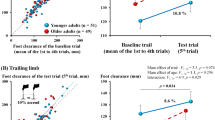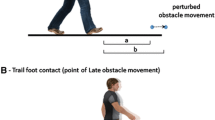Abstract
In the present study the obstacle avoidance strategy during treadmill walking was investigated in ten young (aged 19–32) and ten older females (aged 65–78). Minimisation of displacement of the foot from its original landing position has been proposed to be the main criterion for the selection of alternate foot placement. Each participant performed 60 obstacle avoidance trials. Foot–obstacle configurations were varied in order to obtain both lengthening and shortening avoidance reactions. For each trial it was calculated how much lengthening and how much shortening of the stride was required minimally for successful avoidance. The difference between required lengthening and required shortening was expressed as a percentage of the control stride length and was used as a measure of minimal displacement. The behavior of young females was in agreement with the minimal displacement criterion. The older females, however, exhibited a strong preference for stride lengthening, even in situations in which stride shortening would be highly favorable. The explanation for the long step strategy preference of the older females is discussed in terms of age-related changes in decision-making, differences between young and older persons in the unobstructed gait pattern, and safety considerations.




Similar content being viewed by others
References
Berg WP, Alessio HM, Mills MM, Tong C (1997) Circumstances and consequences of falls in independent community-dwelling older adults. Age Ageing 26:261–268
Chen HC, Ashton-Miller JA, Alexander NB, Schultz AB (1991) Stepping over obstacles: gait patterns of healthy young and old adults. J Geront A Biol Sci Med Sci 46:M196–M203
Chen HC, Ashton-Miller JA, Alexander NB, Schultz AB (1994a) Age effects on strategies to avoid obstacles. Gait Posture 2:139–146
Chen HC, Ashton-Miller JA, Alexander NB, Schultz AB (1994b) Effects of age and available response time on ability to step over an obstacle. J Geront A Biol Sci Med Sci 49:M227–M233
Chen HC, Schultz AB, Ashton-Miller JA, Giordani B, Alexander NB, Guire KE (1996) Stepping over obstacles: dividing attention impairs performance of old more than young adults. J Geront A Biol Sci Med Sci 51A:M116–M122
Chou LS, Draganich LF (1997) Stepping over an obstacle increases the motions and moments of the joints of the trailing limb in young adults. J Biomech 30:331–337
Chou LS, Draganich LF (1998) Increasing obstacle height and decreasing toe–obstacle distance affects the joint moments of the stance limb differentially when stepping over an obstacle. Gait Posture 8:186–204
Hahn ME, Chou LS (2004) Age-related reduction in sagittal plane center of mass motion during obstacle crossing. J Biomech 37:837–844
Lord SR, Fitzpatrick RC (2001) Choice stepping reaction time: a composite measure of falls risk in older people. J Gerontol A Biol Sci Med Sci 56:M627–M632
Lord SR, St. George R, Rogers RW, Fitzpatrick RC (2003) Decision and movement components of choice stepping reaction time: effects of age. In: Lord SR, Menz HB (eds) Program and Abstract Book, ISPGR Society, XVIth conference, Sydney, Australia
Lundin-Olsson L, Nyberg L, Gustafson Y (1997) ‘Stops walking when talking’ as a predictor of falls in elderly people. Lancet 349:617
McFadyen JB, Winter DA (1991) Anticipatory locomotor adjustments during obstructed human walking. Neurosci Res Commun 9:37–44
McFadyen BJ, Magnan GA, Boucher JP (1993) Anticipatory locomotor adjustments for avoiding visible, fixed obstacles of varying proximity. Hum Mov Sci 12:259–272
Patla AE, Prentice SD (1995) The role of active forces and intersegmental dynamics in the control of limb trajectory over obstacles during locomotion in humans. Exp Brain Res 106:499–504
Patla AE, Rietdyk S (1993) Visual control of limb trajectory over obstacles during locomotion: effect of obstacle height and width. Gait Posture 1:45–60
Patla AE, Prentice SD, Robinson C, Neufeld J (1991) Visual control of locomotion: strategies for changing direction and for going over obstacles. J Exp Psychol Hum Percept Perform 17:603–663
Patla AE, Prentice SD, Martin C, Rietdyk S (1992) The bases of selection of alternate foot placement during locomotion in humans. In Woollacott M, Horak F (eds) Posture and gait: control mechanisms. University of Oregon Press, Eugene, Oregon, pp 226–229
Patla AE, Prentice SD, Gobbi LT (1996a) Visual control of obstacle avoidance during locomotion: strategies in young children, young and older adults. In: Ferrandez AM, Teasdale N (eds) Changes in sensory motor behavior in aging. Elsevier Science, The Netherlands
Patla AE, Rietdyk S, Martin C, Prentice S (1996b) Locomotor patterns of the leading and the trailing limb as solid and fragile obstacles are stepped over: some insights into the role of vision during locomotion. J Mot Behav 28:35–47
Patla AE, Prentice SD, Rietdyk S, Allard F, Martin C (1999) What guides the selection of alternate foot placement during locomotion in humans. Exp Brain Res 128:441–450
Perry J (1992) Gait analysis—normal and pathological gait. Slack Incorporated, USA
Schillings AM, Van Wezel BMH, Duysens J (1996) Mechanically induced stumbling during human treadmill walking. J Neurosci Meth 67:11–17
Schillings AM, Van Wezel BMH, Mulder T, Duysens J (1999) Widespread short-latency stretch reflexes and their modulation during stumbling over obstacles. Brain Res 816:480–486
Schillings AM, Van Wezel BMH, Mulder T, Duysens J (2000) Muscular responses and movement strategies during stumbling over obstacles. J Neurophysiol 83:2093–2102
Shumway-Cook A, Brauer S, Woollacott M (2000) Predicting the probability for falls in community dwelling older adults using the Timed Up and Go test. Phys Ther 80:896–903
Varraine E, Bonnard M, Pailhous J (2000) Intentional on-line adaptation of stride length in human walking. Exp Brain Res 130:248–257
Weerdesteyn V, Schillings AM, van Galen GP, Duysens J (2003) Distraction affects the performance of obstacle avoidance during walking. J Mot Behav 35:53–63
Winter DA (1991) The biomechanics and motor control of human gait: normal and pathological. University of Waterloo Press, Waterloo
Acknowledgements
We would like to thank Inger Sierevelt for her help in the data collection. This study was supported by the Dutch Science Foundation (NWO), the Institute for Fundamental and Clinical Human Movement Sciences (IFKB), and an EU grant (Eurokinesis).
Author information
Authors and Affiliations
Corresponding author
Rights and permissions
About this article
Cite this article
Weerdesteyn, V., Nienhuis, B., Mulder, T. et al. Older women strongly prefer stride lengthening to shortening in avoiding obstacles. Exp Brain Res 161, 39–46 (2005). https://doi.org/10.1007/s00221-004-2043-6
Received:
Accepted:
Published:
Issue Date:
DOI: https://doi.org/10.1007/s00221-004-2043-6




